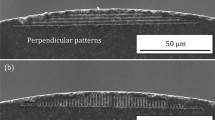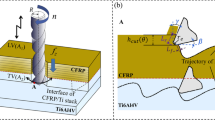Abstract
Titanium alloys are regarded as difficult-to-cut materials because of their low thermal conductivity at elevated temperature; elastic recovery of machined surface near the clearance face of cutting tool in single-point diamond turning (SPDT) is unavoidable, causing an extensive tool tip vibration. The tool tip vibrates at a high frequency with small amplitudes in SPDT, resulting of poor surface integrity. Focusing on the problematic tool tip vibration occurred in SPDT, in this paper, the preliminary work was conducted on investigating the influences of eddy current damping effect on the tool tip vibration in SPDT of titanium alloys, showing the reduction of the tool tip vibration. In the experiments, titanium alloys were rotated in between of two permanent magnets and suffered from an eddy current damping effect. The experimental results showed that tool marks caused by the small tool movements in the tool tip vibration were highly reduced, resulting in improvements of surface roughness and surface profile. Moreover, because of the dissipation of kinetic energy of tool tip vibration by the additional eddy current damping factor, the characteristic peak ratio (CPR) decreased too, which it accurately predicted that surface roughness of machined surface decreased with the CPR increase and magnetic field intensity increase. The proposed study provides an effective machining technology to reduce the unsolvable tool tip vibration in SPDT by using an eddy current damping effect.
Similar content being viewed by others
References
Che-Haron CH, Jawaid A (2005) The effect of machining on surface integrity of titanium alloy Ti-6% Al-4% V. J Mater Process Technol 166:188–192
Ezugwu EO, Wang ZM (1997) Titanium alloys and their machinability—a review. J Mater Process Technol 68:262–274
Arrazola P-J, Garay A, Iriarte L-M, Armendia M, Marya S, le Maître F (2009) Machinability of titanium alloys (Ti6Al4V and Ti555. 3). J Mater Process Technol 209:2223–2230
Rahman M, Wang Z-G, Wong Y-S (2006) A review on high-speed machining of titanium alloys. JSME Int J Ser C Mech Syst Mach Elem Manuf 49:11–20
Ginting A, Nouari M (2009) Surface integrity of dry machined titanium alloys. Int J Mach Tools Manuf 49:325–332
Che-Haron CH (2001) Tool life and surface integrity in turning titanium alloy. J Mater Process Technol 118:231–237
Rack HJ, Qazi JI (2006) Titanium alloys for biomedical applications. Mater Sci Eng C 26:1269–1277
Hao YL, Li SJ, Sun SY, Zheng CY, Hu QM, Yang R (2005) Super-elastic titanium alloy with unstable plastic deformation. Appl Phys Lett 87:91906
Wang H, To S, Chan CY et al (2010) A theoretical and experimental investigation of the tool-tip vibration and its influence upon surface generation in single-point diamond turning. Int J Mach Tools Manuf 50:241–252
Wang H, To S, Chan CY (2013) Investigation on the influence of tool-tip vibration on surface roughness and its representative measurement in ultra-precision diamond turning. Int J Mach Tools Manuf 69:20–29
Taniguchi N (1983) Current status in, and future trends of, ultraprecision machining and ultrafine materials processing. CIRP Ann 32:573–582
Takasu S, Masuda M, Nishiguchi T, Kobayashi A (1985) Influence of study vibration with small amplitude upon surface roughness in diamond machining. CIRP Ann Technol 34:463–467
Zhang SJ, To S (2013) A theoretical and experimental investigation into multimode tool vibration with surface generation in ultra-precision diamond turning. Int J Mach Tools Manuf 72:32–36
Wang H, To S, Chan CY et al (2011) Dynamic modelling of shear band formation and tool-tip vibration in ultra-precision diamond turning. Int J Mach Tools Manuf 51:512–519
Kishore R, Choudhury SK, Orra K (2018) On-line control of machine tool vibration in turning operation using electro-magneto rheological damper. J Manuf Process 31:187–198
Chen F, Liu G (2017) Active damping of machine tool vibrations and cutting force measurement with a magnetic actuator. Int J Adv Manuf Technol 89:691–700
Paul PS, Raja P, Aruldhas P, Pringle S, Shaji E (2018) Effectiveness of particle and mass impact damping on tool vibration during hard turning process. Proc Inst Mech Eng B J Eng Manuf 232:776–786
Lawrance G, Paul PS, Varadarajan AS et al (2017) Attenuation of vibration in boring tool using spring controlled impact damper. Int J Interact Des Manuf 11:903–915
Cheung CF, Lee WB (2000) A theoretical and experimental investigation of surface roughness formation in ultra-precision diamond turning. Int J Mach Tools Manuf 40:979–1002
Ma J, Zhang D, Wu B, Luo M, Chen B (2016) Vibration suppression of thin-walled workpiece machining considering external damping properties based on magnetorheological fluids flexible fixture. Chin J Aeronaut 29:1074–1083
Ebrahimi B, Khamesee MB, Golnaraghi MF (2008) Design and modeling of a magnetic shock absorber based on eddy current damping effect. J Sound Vib 315:875–889
Sodano HA, BaeJ-S IDJ, Belvin WK (2006) Improved concept and model of eddy current damper. J Vib Acoust 128:294–302
Bae J-S, Kwak MK, Inman DJ (2005) Vibration suppression of a cantilever beam using eddy current damper. J Sound Vib 284:805–824
Sodano HA, Bae J-S, Inman DJ, Belvin WK (2005) Concept and model of eddy current damper for vibration suppression of a beam. J Sound Vib 288:1177–1196
Ebrahimi B, Khamesee MB, Golnaraghi F (2009) A novel eddy current damper: theory and experiment. J Phys D Appl Phys 42:75001
Ebrahimi B, Khamesee MB, Golnaraghi F (2010) Permanent magnet configuration in design of an eddy current damper. Microsyst Technol 16:19–24
Yip WS, To S (2017) An application of eddy current damping effect on single point diamond turning of titanium alloys. J Phys D Appl Phys 50:435002. https://doi.org/10.1088/1361-6463/aa86fc
Yip WS, To S (2017) Reduction of material swelling and recovery of titanium alloys in diamond cutting by magnetic field assistance. J Alloys Compd 722:525–531. https://doi.org/10.1016/j.jallcom.2017.06.167
Chen Y, Li H, Wang J (2015) Analytical modelling of cutting forces in near-orthogonal cutting of titanium alloy Ti6Al4V. Proc Inst Mech Eng C J Mech Eng Sci 229:1122–1133
Lee WB, Cheung CF (2001) A dynamic surface topography model for the prediction of nano-surface generation in ultra-precision machining. Int J Mech Sci 43:961–991
Acknowledgments
The work described in this paper was supported by General Research Fund of University Grant Committee of Hong Kong Special Administrative Region (Project Code POLYU152125/18E) and the National Natural Science Foundation of China (51675455).
Author information
Authors and Affiliations
Corresponding author
Additional information
Publisher’s note
Springer Nature remains neutral with regard to jurisdictional claims in published maps and institutional affiliations.
Rights and permissions
About this article
Cite this article
Yip, W.S., To, S. Reduction of tool tip vibration in single-point diamond turning using an eddy current damping effect. Int J Adv Manuf Technol 103, 1799–1809 (2019). https://doi.org/10.1007/s00170-019-03457-z
Received:
Accepted:
Published:
Issue Date:
DOI: https://doi.org/10.1007/s00170-019-03457-z




